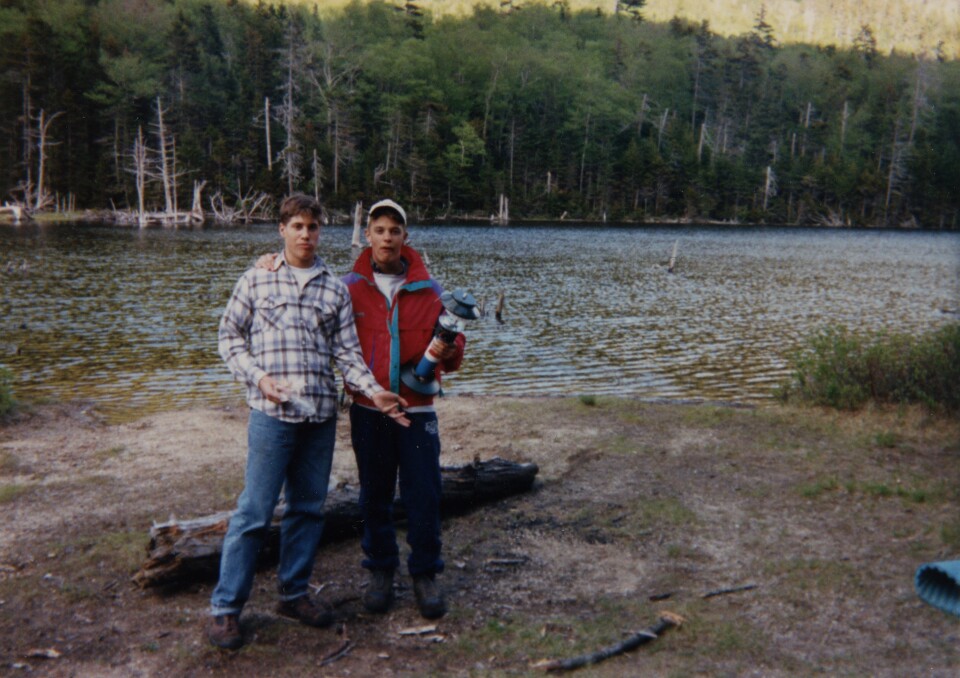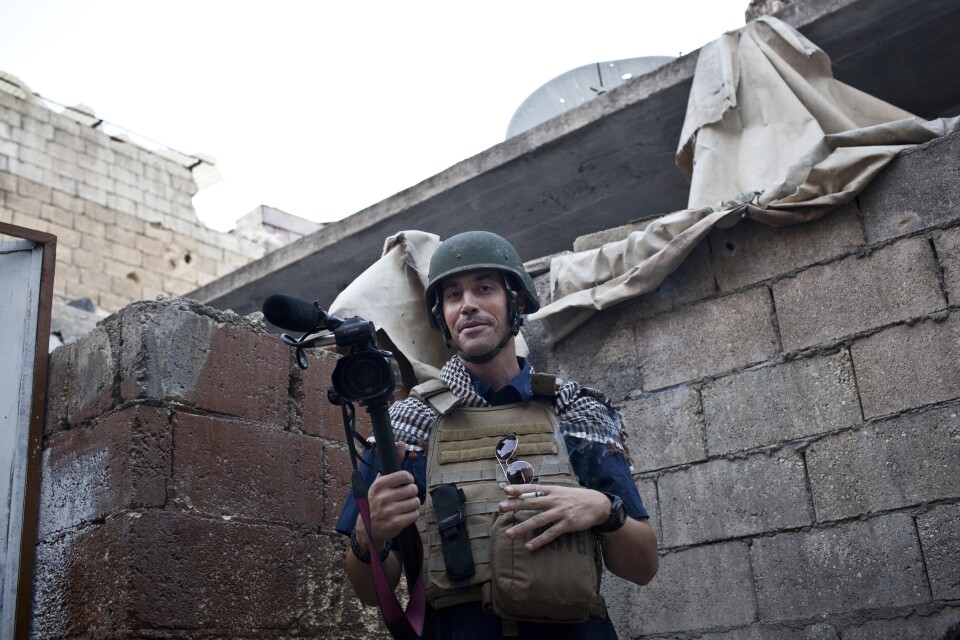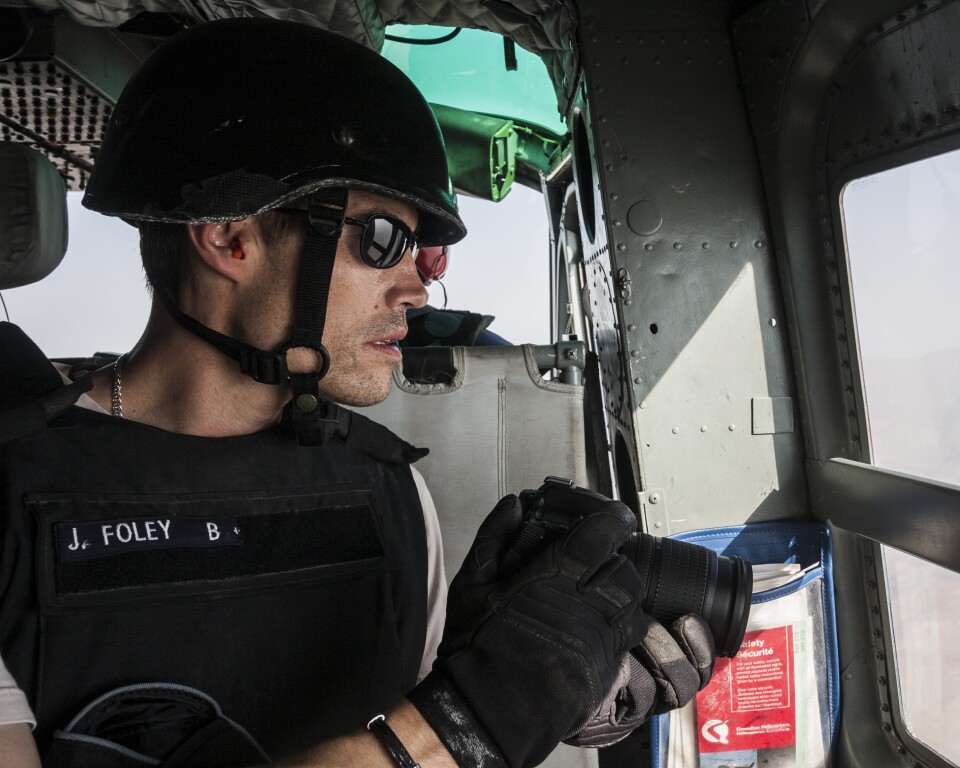Brian Oakes tells the story of his childhood friend who became a conflict journalist in "Jim: The James Foley Story"; Mark Mangini made a battle truck sound like a living beast in "Mad Max: Fury Road"; residents of Leimert Park and Montebello connect in "Through the Looking Glass."
'Mad Max' sound designer Mark Mangini was inspired by 'Moby Dick'
“Mad Max: Fury Road” is an intense action film that uses mostly real stunts. It’s surprising because the majority of action films now rely heavily on digital tricks and computer-generated images.
But there’s one element in “Mad Max” where fiction plays a huge role in creating a believable atmosphere — the film’s sound. Mark Mangini is the sound designer behind the film and he’s nominated for an Oscar this year (along with David White) for sound editing.
The Frame’s James Kim spoke with Mangini about how a famous novel inspired his approach to “Mad Max: Fury Road."
INTERVIEW HIGHLIGHTS
What inspired you to create the sounds for "Mad Max"?
I had this notion that the truck itself was an allegory for "Moby Dick." If you think about this a little bit, we saw Immortan Joe — the leader of the war party — as [Captain] Ahab. He's hellbent on killing the great white whale — the War Rig.
We wanted to personify it as this giant, growling, breathing, roaring beast. It had to be grounded in reality, but we wanted it to be more than that, so we designed whale sounds to play underneath all those truck sounds to embody the real sounds and to personify it.
And to further that storytelling aspect, the "Moby Dick" aspect, at the end of the movie they're shooting harpoons at it. We already have the visual metaphors to support this allegory. Every time it was struck with a harpoon, you hear these deep whale-like groans to say that it has been hurt and wounded. It's not just the sound of metal into metal. When the harpoons do pierce the War Rig and the milk sprays out, we use the sounds of whale blowholes.
Was there a particular scene that you worked on that emphasizes your work on the film?
At the end of the film, when Nux, Nicholas Hoult's character, throws the War Rig into a t-bone maneuver to sacrifice himself and block the pass so that Immortan Joe's party can't get through and continue to chase our heroes, we go into a beautiful ballet-like slow motion sequence as the War Rig upends and turns on its side and crashes. All those sounds, there are no realistic sounds there. Those are all whale sounds and actually slowed-down bear sounds.
What we wanted to say to the audience was, This is a death. This is the death of the great white whale. All you hear as it rolls over in slow motion is the final death rattle of a dying creature. It just felt like the right sound to use.
What do you want the audience to take away from your work on the film?
It's my goal to convince the audience that what they're hearing really happened and all we really did was we went to that location and hung a microphone and everything you heard got captured in real time. Of course, nothing could be further from the truth. Every single sound, no matter how subtle or simple — from the simplest little footstep sound to a humpback whale — is considered, composed [and] orchestrated to have an affect on the audience.
So I really need to find a way to step as far back from the artifice of what I'm doing. And sometimes that begins with finding the most real sounds I can so that it's the most believable to you as the audience.
‘Through the Looking Glass’: How residents of 2 LA neighborhoods found common ground
You don’t usually hear Leimert Park and Montebello in the same sentence, but the two L.A. County neighborhoods actually have a lot in common.
Both have middle-class, diverse populations — a largely African-American community in Leimert Park, and a mix of Latinos, Asians and Armenians in Montebello.
So with only 16 miles separating them, why do these communities seem worlds away?
MAXWELL MARTINEZ: When I heard Leimert Park, I didn’t have any assumptions because I didn’t know what Leimert Park was. . .
Montebello resident Maxwell Martinez is a participant in Center Theater Group’s project, “Through the Looking Glass,” which recruited residents of Leimert Park and Montebello to write “autobiographies” about each other’s cities. The stories have been adapted into a new stage production by playwright Jerry Quickley.
Speaking at the final rehearsal for the show, one Leimert Park participant said she had a surprising response when meeting the group from Montebello last month.
TASHA W. HUNTER: When we finally met in person, the demographic of people, just to see a variation of ages and colors and hues and backgrounds — that surprised me. It was a reflection of us.
Quickley, who is also the project’s facilitator, said the idea for “Through the Looking Glass” came from a similar project he’d done with students at Stanford University and incarcerated youth in Alameda.
QUICKLEY: Whether I’m working with [the participants], or building an opera with Philip Glass, or working with incarcerated youth, it’s all the same process. You have to come in with very open ears, you go up and have a conversation, and you see what those conversations develop into.
On opening night, the participants will be on stage telling their stories, which they’ve been developing over the past seven months.
QUICKLEY: Creating a safe space that allows people to unpack their traumas and allows people to go into detail about that is really one of the keys to us being able to get at what’s underneath the community; what’s driving them, what frames are being repeated from one community to another.
Diane Rodriguez is Center Theater Group’s associate artistic director. She says the project is important because of the lasting effects storytelling can have on the performers.
RODRIGUEZ: They get a confidence that their story is important; they get skills in terms of how to communicate those stories. . . . What all that does is it empowers people. It gives them more of a feeling of self-worth and it’s going to impact their lives beyond this project.
That’s something Maxwell Martinez can attest to. After surviving a stroke nearly five years ago, he says “Through the Looking Glass” became a way for him to break out of his shell.
MARTINEZ: I was a shut-in after the stroke. I fell into a deep depression and I shut myself into my room, and for four years I was in that room. I didn’t want to come out, I didn’t go out. . . this really helped me break out of that depression and find a new me, find a creative me.
Quickley says stories like Martinez’s are why he’s developed the project.
QUICKLEY: Maxwell was basically ready to give up on life. He needed to make a transition to do it. He’s working now. He’s fully engaged, and to watch someone grow through that journey is affecting.
And Quickley hopes their audience will walk away with more than just a night of affecting stories.
QUICKLEY: What I hope the audiences will take away from this project is, how our cultural expressions can be very different, but there is a tremendous amount of closeness in every way. I want the audience to take away that your plight matters. And what I’m hoping most is that people come to the performance and they see their plight on stage. They see the life or lives that they’ve lived on stage and that they see themselves in the work of others.
“Through the Looking Glass” will be performed Feb. 2 at the Quiet Cannon in Montebello, Feb. 3 at Regency West in Leimert Park, and Feb. 8 at the Kirk Douglas Theatre in Culver City.
HBO's 'Jim' tells the backstory of murdered journalist James Foley
Brian Oakes makes his directorial debut with "Jim: The James Foley Story," a documentary that explores the intersection of terrorism and conflict journalism through the life of James Foley. The film received the Audience Award for a U.S. Documentary at the Sundance Film Festival, and it will premiere on HBO this month.
The Islamic State group released a video in August, 2014 of Foley's beheading. In the video, Foley is shown kneeling in the desert with his head shaved and wearing an orange jumpsuit. His captor stands over him clad all in black with his face covered. The captor's strong British accent suggested that he was recruited from the U.K.
Foley had been a war correspondent stationed in Syria to cover the country's civil war when he was captured in November, 2012. Before his murder, he was forced to read a statement blaming U.S. airstrikes in the Middle East for his death.
The graphic video's release ramped up Western attention to the crisis in the Middle East and the development of the militant Islamic group, especially its ability to recruit internationally.
In making his documentary, Brian Oakes wanted to repurpose the images of his childhood schoolmate's last moments. To Oakes and the journalists that Foley worked with, James was "Jim" — a friend who was passionate about his work. The film reveals who Foley was before that fateful day, and tracks how he ended up there.

The Frame's John Horn met with director Brian Oakes at the Sundance Film Festival to talk about the film and how Oakes remembered Foley.
INTERVIEW HIGHLIGHTS
I've known Jim since we were seven years old. We were first-graders together in a little rural town called Wolfeboro, New Hampshire. He really loved people. He loved their stories, telling their stories, and specifically people [who were] kind of the underdogs. And I think when he was doing his embed with the U.S. troops, he saw a lot what was [happening] on the other side.
The other side being the victims of war, the people who are suffering at the hands of the war or an oppressive government?
Absolutely... The recipe of a war correspondent is very specific. I think it's a very rare breed. And Jim had a lot of those characteristics. You need to have physical courage. You need to have moral courage. And you need to be able to be calm under very stressful situations. And in a way, they have a lot of soldier-like qualities.

Early on in the film, one of Jim's brothers asks the question, "Why?" It's a question that kind of echoes throughout the film. Why was he in Syria? Why was he chosen to be assassinated by ISIS? As you're making the movie, was [answering those questions] part of the motivation on your part, or were you trying to figure out more about who Jim was beyond what you knew?
There are a lot of layers to that answer. But I would say the thesis of the film is, Why was Jim over there? And not only that, but why did he go back?
And we should point out, he went back to the Middle East after he had already been kidnapped in Libya. And he went back to Syria, which was even a more dangerous place.
Correct. And I think that it's a question for Jim specifically, but it's also a question [of], Why do conflict journalists do what they do? What is the draw? Conflict journalism has always existed. The job has changed. But it's always existed. So there is an extreme importance for what these conflict journalists are doing on the front lines, to capture what is going on and to give us the information.
There's a kind of a job for them that they feel they're doing. There's also another layer to this and it's about providing context of what these guys are seeing. And it has that kind of soldier-esque quality. These guys are going in and they're seeing children being bombed... And when you see these things, this really affects you and it becomes a reality to them. And when you leave that reality, when you leave those war zones and you come back to the world that we live in, it becomes very difficult for them to process.
We talk about it as almost this siren song. It's like a drawback — I need to kind of go back there. And it's an important topic. Again, it's the thesis because when Jim was killed, there was a lot of that same question. Why was he there? He knew it was dangerous. And personally, I had that question myself, too. And doing this film was a great way for me to answer that.
Was the question answered for you, why he did it? Why he wanted to be there?
Absolutely.
And was part of your motivation in making the film to answer that question, and was it also partly to figure out how to process the loss of your good friend? Were those two things joined in some ways, in the making of the film?
I've never really thought about it being a process of dealing with it. I don't know if I'll ever have closure, if that's what you're asking. Closure is a tough word. Meeting up with those former hostages and understanding what he went through was a total discovery for me. In that way I was able to process it and that was really amazing.
But I would say, another reason for doing this film is [that] Jim was in Syria three years ago telling these stories of these civilians. And right now we're seeing the largest refugee crisis in the world since World War II. And the stories that he was telling three years ago are so relevant right now. I wanted the film to help Jim bring those stories back to the surface and carry on the amazing work that he was doing.

Towards the end of the film there's a clip where one of Jim's brothers reads a letter that Jim wanted to send out from captivity. What's the importance of the letter in terms of what Jim was thinking about and what his concerns were in the last days of his life?
...It's a letter to his family. And it's personal. And I think with the video, they intended to show that these are Jim's last words — scripted words that he was made to say.
In which he denounces the country, essentially.
Yeah. But those weren't his last words. His last words were his letter to his family.
You say at the start of the film that there are going to be images of conflict in the film, but you will not show Jim's execution. I guess as a film watcher, you kind of know that you're not going to see this horrible thing. But I suspect that's not entirely what you were trying to do, to shield the audience. There's a bigger idea behind not showing that.
Yeah. I think the image of Jim, whether it's the photograph of Jim kneeling in the desert in his orange jump suit that we all are familiar with — and then there's the actual video. And at the very beginning of the process of filmmaking I was very hesitant to use any of that. Because my thought was, Why would I want to show that? This is a film about Jim. And as I got through the filmmaking process, I soon started to realize that people need to know who you're talking about. And people know James Foley as this figure. And so you need to show your viewer who this film is about as you know him.
But at the same time, there's a huge sensitivity because another layer of why I made this film is I wanted to re-contextualize that image. It's the reason I call the film "Jim." The world knows him as James Foley. I always knew him as Jim. And if I'm able to show you who this man was, the amazing things he was doing and what a normal person he was, and you understand where he's coming from and what he's doing — you look at that image again and it takes on a completely different meaning. Because now you know who's behind that figure sitting in the desert. There's good and evil in that photo. And to me I feel like we're taking it away from its intended use, and now we're owning it.




